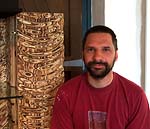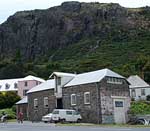Having the opportunity as a youngster to spend my summers in the forests and lakes of Northern Michigan I'm sure has affected what I'm doing right now. I remember being in the forest and playing with sticks, assembling them, and liking the feeling of being with the trees.
Wood designer-maker Mark Bishop

I'm a self-taught wood turner. That didn't satisfy me in some way, there was something missing. So I toddled off to the Canberra School of Art and spent a couple of years there doing a furniture-based wood course.
You have to have a real desire to make objects I guess. You start making, developing, learning, achieving what you do with each piece. And as you make each piece, the next piece follows.
The first thing I ever made was an egg cup. My mother's still got it. She brings it out now and then to embarrass me and hides it thereafter because pieces that I'm not happy with don't make it to the public eye anymore, they get burnt. If you're a ceramicist you smash your pots, if you're a wood worker you burn them!
I grew up near Stanley. Being a very small country town of course I always wanted to leave. If someone had suggested to me when I was 16 that I would leave Stanley and come back I would have questioned their sanity.
And I'm back where I grew up. When you're growing up it's a tiny town with no opportunities and nothing to do, but now it's paradise.
I am definitely influenced by my environment. If the environment you live in becomes irrelevant, then you're dead as an artist no matter where you live. You shouldn't fight it.

The spectacular physical natural surroundings of Tasmania have got to have an effect on your work. I spend a lot of time walking along beaches. I love walking along the beach, the wide open space. And I do enjoy a city environment as well, that's exciting because I don't access that a lot.
The history of forestry practices in Tasmania is no different to the history of the exploitation of natural resources in Australia. Australia is a country that is so rich in natural resources, mining, aquaculture, crops of wheat, that it has really influenced our psyche and we have become an incredibly wasteful society. We don't value it.
I don't collect anything. I find it quite an interesting contrast that I make objects for people to aspire to want to own and live with, but I really don't want to live with any of them myself. I've made pieces for my family but for me… a white room will do!
I do think it's different seeing your pieces in museums than seeing them in someone's house. I actually think it's better to see work in someone's house where it's being used for the purpose it was made for. When you make furniture, even though it's decorative, it does have a purpose and it's designed to be used.
Occasionally as a maker you are attracted to things but you soon exhaust their possibilities. It's part of that appetite that you have for looking and for investigating things. There's very few things that I'd like to own after I've looked at
them a couple of times. You eat them up, spit them out and go on to the next thing.
Related
I turned to furniture mid-career. I was actually trained as a musician and a high school teacher and I decided to do something else. I'd done a lot of building before and I suddenly decided to build stuff that I was going to sell instead of keep.
About fifteen years ago I bought a little house that I was going to renovate but I could never find anyone to do things exactly as I wanted them.
I was born in Melbourne and I've been in Tasmania for about 14 years. I like Tasmania because I like the bush, I like the weather, I like the timber. It's a much more natural environment than the mainland. The landscape here is inspirational to my work.
My workshop is on part of the family farm and I've lived alongside it or near it all my life apart from the occasions where I've been studying or working overseas or interstate.
I was born in Tasmania. My father was in the timber industry so I was always surrounded by stories of timber and things like that. I left school at 14 to do a trade in joinery. Prior to that I was more interested in making boats.
I came to Australia in 1970 to take up a teaching position at the Tasmanian School of Art. We were probably some of the last of the Ten Pound Poms. I was very keen after going through college in the UK to travel overseas and try other cultures.
I remember carving when I was about 8. I used to steal my mum's lino carving tools. I was able to go down to the workshop in the garage and carve away. I think the first thing I came up with was an acanthus leaf. I was really pleased with that.








